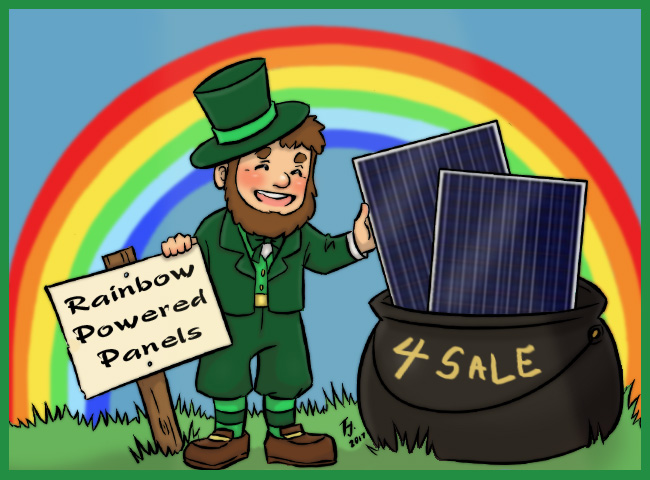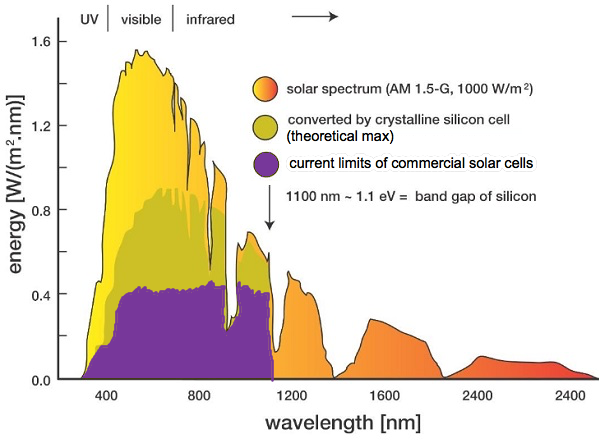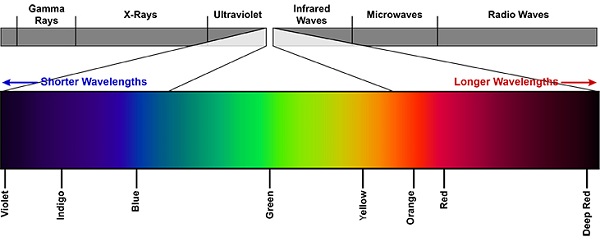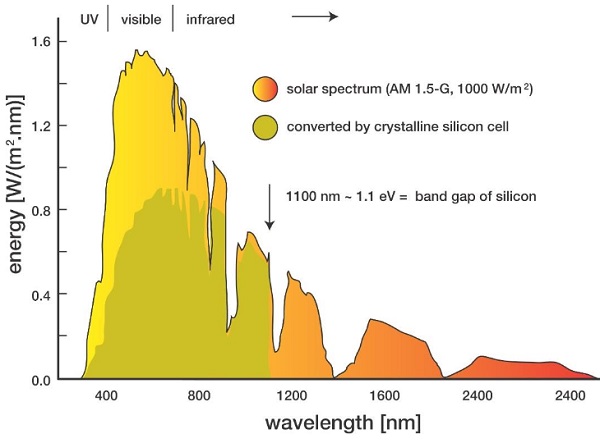
We are getting reports of people paying through the nose for 5kW of “UV Solar Panels” from fast talking salespeople. Paying more for “UV Panels” is about as sensible as buying rainbow powered panels from a leprechaun.
The sun is a very large, naturally occurring, fusion reactor in the sky.
It constantly releases a vast amount of energy. Even by the standards of sky fusion reactors it’s pretty powerful and outshines at least 90% of the stars out there.
How powerful is it?
Well, if you took:
- all the energy humanity produces in from burning coal, oil, and natural gas
- and all the energy from the fission of uranium and other elements in nuclear reactors
- and all the energy spun out of wind
and then took the total for an entire year, it comes to around the amount of sunlight energy hitting the earth every hour.1
Update Nov 15 2021: I originally had 7 seconds rather than an hour, but it has been pointed out to me that is not enough.
Sunlight energy arrives in the form of photons, which is a word that means ‘the smallest amount of light possible’. These photons have different wavelengths2 with longer wavelengths having less energy and shorter wavelengths having more.
If a photon doesn’t have enough energy our eyes can’t see it. The same goes if it has too much energy. But if photons are just Goldilocks, then our eyes can see them and we call them visible light.
Photons that don’t have enough energy to be seen are called infrared and those with too much are called ultraviolet.
Sunlight energy that reaches the ground is around 4% ultraviolet, 43% visible light, and 53% infrared. Solar panels mostly convert visible light into electrical energy, and they also can make use of almost half the infrared energy. But solar panels only use a small portion of ultraviolet.
Why UV Panels are a con job
Because ultraviolet is such a small percentage of sunlight energy, if anyone ever tries to sell you a panel they claim uses ultraviolet light, then if ultraviolet is all it uses it is really, truly, crap compared to a normal panel. Or if it somehow functions like a normal panel as well as making uses of ultraviolet, then it wouldn’t be that much of an improvement over an ordinary panel. It would just be maybe 5% more efficient. That’s enough to make a 20% efficient panel 21% efficient.
As solar panels that can make good use of ultraviolet don’t really exist, even that modest improvement is not realistic. While you can get solar cells that make better use of ultraviolet for use in space, those cells aren’t used in panels you can put on your roof.
Sunlight In Space
Because the sun is a giant, uncontrolled, nuclear reactor, you might think that it would create a great deal of dangerous radiation. And you’d bloody well be right. But because the nuclear reactions happen deep within the sun’s core and the sun is what we scientists call very, very, big the deadly radiation can’t get out.
Light itself can have a hard time escaping the sun and it can take 100,000 years for a photon to get from the center of the sun to its surface. From there it only takes 8 minutes and 20 seconds to splat into someone’s solar panel.
Compared to its total energy output the sun only produces a trivial amount of high energy radiation such as x-rays and gamma rays. But if you are a fragile organic being traveling into space, that trivial amount could become rather important, so I recommend taking precautions3.
Sunlight On Earth
By the time sunlight energy reaches the top of earth’s atmosphere its intensity will be around 1,366 watts per square meter4. Passing through the atmosphere will reduce that by 18% down to 1,120 watts. Mind you, that’s 1,120 watts at noon, at the equator, on a clear day.
Because conditions are rarely perfect, Standard Test Condition (STC) for solar panels is set at the nice round number of 1,000 watts per square meter. This means if you have a 270 watt panel it will provide that many watts of electrical power when exposed to sunlight of 1,000 watts per square meter.
And don’t worry — nothing in your solar system will blow up or break if sunlight exceeds that amount. Hardware manufacturers and system designers take it into account. They also take into allow for sunlight intensity going even higher if it shines through a hole in clouds and panels are hit at the same time by direct sunlight and indirect light scattered by surrounding clouds.
Sunlight Spectrum
This diagram from Wikipedia commons (I must remember to give them some money at some point) shows how much sunlight gets through to the earth’s surface. The yellow area shows the amount of sunlight hitting the top of the atmosphere , and the red area is how much reaches the ground.

Image source: Wikipedia commons
At noon, at the equator the atmosphere reduces sunlight energy hitting the ground by 18%. However the graph above isn’t a snap shot taken under ideal conditions at noon on the equator, but is instead representative of sunlight hitting the earth as a whole. This is why it shows the atmosphere taking a lot more than an 18% bite out of sunlight. In the morning and afternoon sunlight passes through more atmosphere before it hits the ground and higher latitudes have a similar effect.
As you can see in the UV column, the atmosphere stops more than half the ultraviolet light, mostly thanks to the ozone layer, which is what the O3 at the bottom left corner stands for. Moving to the right, more than one quarter of visible light is lost and then the atmosphere takes some big bites out of infrared. The big pieces missing from the red are the result of gases in the atmosphere absorbing specific bands of sunlight energy before it hits the ground5.
The Visible Light Spectrum
Examining only the visible light section of the sunlight spectrum shows it is made of a beautiful rainbow of colors, as this image that fell off the back of a truck on its way to the US National Oceanic And Atmospheric Administration displays:
As you can see, the spectrum as six colors.
Wait a minute, let me change that…
As far as I can see, the spectrum has six colors.
As far as Issac Newton could see the spectrum had seven colors.
The people who made this image decided to tack deep red on at the end, making for eight colors.
And for all I care, you can divide it into as many different shades and call them colors as you like.
The mnemonic I use to remember Zaccy Newt’s seven colors is Roy G. Biv. This stands for Red, Orange, Yellow, Green, Blue, Indigo, Violet.
Visible light starts at a wavelength of around 390 nanometers and ends with red (or deep red) at around 700 nanometers. A nanometer is one billionth of a meter.
Spectrum Of Sunlight Used By Silicon PV
Now here is a spectrum I stole from the University of NSW. It shows sunlight reaching the ground as the one I used earlier does, but this one uses a horrible greenish-grey color to show what portion of sunlight energy a silicon solar panel could convert into electrical energy:
There is a problem with this graph because it shows 49% of the energy being converted to electricity and this is much too high. The highest efficiency of any solar panel that can be bought today is around 23% which is less than half the amount shown. So I drew on the original diagram with my purple pen to show how much light gets converted by such a solar panel. Note that whilst the area is about the correct size – the shape of the enclosing line is a guess.

A doctored version of the first diagram to show how much light is used by a commercially available panel.
As you can see, silicon solar panels can manage to use some of the ultraviolet portion of sunlight on the far left. The amount increases as it becomes visible light and panels go on to produce most of their electricity from visible light.
Unlike with ultraviolet, in the infrared there is a very sharp cutoff in the sunlight energy used by the panel at 1,100 nanometers. This is because wavelengths longer than this simply ignore the silicon atoms and pass by them with little or no effect. The silicon is transparent to infrared of this wavelength or longer.
Multi-junction Solar Cells
A multi-junction solar cell is basically several solar cells crammed into one, with each part specializing in a portion of the spectrum of sunlight energy. The diagram below, that I stole from the Fraunhofer Institute for Solar Energy Systems, shows an example:

Ultraviolet Panels Don’t Really Exist
Today silicon solar panels make up over 97% of world panel production. The rest is almost entirely cadmium telluride thin film panels produced by companies such as First Solar. These panels can use slightly more infrared than silicon ones, but they should also use slightly less ultraviolet.
Currently people are working to increase the amount of ultraviolet solar panels use. Despite this, all currently available panels are visible light panels first, infrared panels second, and ultraviolet panels only as a distant third. So little ultraviolet hits the earth’s surface that nothing is likely to ever change this. So if a salesperson tells you they have an ultraviolet panel, they are either not being truthful or they don’t know what they are talking about.
What Matters Is A Panel’s Watts And Efficiency
Because ultraviolet only makes up a small portion of the energy in sunlight, the amount of ultraviolet light a panel uses is not going to make much difference to its performance. All else equal, the more ultraviolet energy it uses the better, but there is no need for anyone who is looking to put panels on their roof to worry about it. An all else equal panel that uses more ultraviolet will have a slightly higher wattage and a slightly higher efficiency and those are figures you can easily use to compare it with other panels. Just how much ultraviolet light it uses shouldn’t be a concern.
Footnotes
- This is for sunlight energy hitting the top of the atmosphere. Around 73% reaches the ground when skies are clear. ↩
- If you are wondering whether light is a particle or a wave, the answer is yes. ↩
- Such as removing all radiation shielding so gamma rays will hulk you up. ↩
- We know this from satellites such as ACRIMSAT, which is a satellite that was banished to space because of its crimes. ↩
- CO2 may not appear to be doing much absorbing of energy here. But while it has little effect on sunlight coming in, its major effect is on longer wave infrared emitted from the ground. ↩



 RSS - Posts
RSS - Posts



Hi Finn
Still on the same topic,
my question is: is it worthwhile to use N type solar cell rather than P type
as it is more reliable and efficient bot more price $/watts
As I know only 2 top brands ( I f I am NOt wrong ) uses N type
Thank you
Regards Mel
Hello Mel
If you have room to spare on your roof then it can definitely be cheaper to use P-type solar panels. But if your goal is to get as much solar electricity as possible out of a limited amount of space, then premium N-type panels will be best because of their high efficiency.
Of course, some people just like having the best panels available, along with their usually excellent replacement warranties.
As panels with panel string optimization are now available for a relatively low premium, it is now easier to place panels on “difficult” roofs that previously might only have had a limited amount of space where it was practical to place panels, so using them instead high efficiency, but more expensive, panels is an option.
I have a 4.5 kwatt off grid system
Now i understand why there us such a spike in solar input at 12-2 pm
Because there is atmospheric distance for the photons to travel to my panels than at 5 pm
Even though the have full sun on them
Ronald I need some advice please. I have 8 BBPV-175 MONOCRYSTALLINE panels on my roof with a 1.5kw SR2000TL inverter. I have just recently had a ACUMEN smart meter installed by Origin Energy. The panels and inverter are now around 7yrs old. I am thinking of expanding the system by installing a couple more panels. In plain simple English please, what would be your advice ?
Hello Danny
There are a few things you can do. Which is best will depend upon your goals and how much you can spend.
(1) You could add solar panels to your existing inverter. But it will be difficult to find 175 watt panels to match your old ones. You can add larger panels, but their performance will be dragged down to that of the weakest existing panel, so a portion of their capacity will simply go to waste. Your maximum panel capacity, whether it is used or not, can be one-third more than your inverter capacity.
(2) You could have a new solar system installed and keep your old one.
(3) You could get a new solar system and have your old one removed.
Without knowing more I can’t say which would be best for you. But, with increased electricity prices and feed-in tariffs, I am tempted to recommend the third option, provided the initial cost would cause you no hardship.
Thankyou very much for your quick response, I will weigh up what you have advised, get some quotes and go from there,. Thanks again.
I had the old photo cell and getting most power from 9am to 3pm when I changed to UV power comes on 6am to 7pm even when cloudy and rain so battery is fully charged by 10am so the ppl on here have just confused themselves with science not in-house working
We’re getting closer to the point where solar panels can utilize UV… recently researchers found they could create ‘photonic matter’ by firing UV through a cloud of ultra-cold rubidium atoms… what came out the other side was 100,000 times slower than the speed of light and had invariant mass, so it wasn’t light (or it’d be traveling at the speed of light and would have no invariant mass), it was matter. This is perhaps the first demonstration of light-to-matter conversion. We’ve seen plenty of matter-to-light conversion, but not a lot of the reverse.
This ‘photonic matter’ was comprised of three photons… they’d found a way of setting up a stable three-photon standing wave in the Higgs field in accordance with E^2 = p^2 c^2 + m^2 c^4, to put it in quantum field theory parlance.
All matter is comprised of standing waves, still traveling at c, but ‘pinging’ back and forth against the Higgs field at ~100 trillion trillion times per second. Thus, it’s stationary and thus invariant from our frame of reference. That’s the primary difference between energy and matter, after all.
So eventually we’ll get to the point where photons are combined as described above, and their combined energy will be high enough to bridge the band gap… meaning solar panels that can operate from the heat thrown off by objects. Solar panels that can even work at night.
The research detailed above also represents maybe the second or third step in the long process of creating a Star Trek-type replicator, making any invariant matter directly from energy.
We’re not there yet, but we’re well on our way.
Hi Ronald,
I’m an educator and I’ve been brainstorming activities to teach kids about invisible wavelengths of light. I bought a small solar panel and wired it to an aux cord. When the cord is plugged into an amp, I can transfer both visible and infrared light into sound. I was wondering if you know if there are any solar panels out there that are sensitive to UV light (I get that it is not the most efficient for generating electricity). I was really hoping to add UV light to the illustration but a UV flashlight just blocks the visible light and does not produce a sound with the panel that I have right now.
Thanks for your help!
Brooke
The most UV sensitive solar cell I know of is amorphous silicon. Looking online I see they can still be bought. I suppose another option would be to use an ordinary silicon solar cell and cover it with a phosphor to convert UV light into visible light but I’m not sure how to go about that. Having kids cut open a fluorescent tube and exposing them to mercury vapor is probably frowned upon these days. Also the phosphor might decay very rapidly when exposed to air.
There are a number of safe ways to convert UK to visible.
1. ‘Dayglow’ coloured highlighter pens work by converting sorter wavelengths to the yellow/green/pink pen colour allowing them to return more of that colour than is incident on them.
2. Security pens allow you to write identifying marks which are revealed by converting UV illumination.
3. According to various CSI dramas, fluids containing DNA fluoresce in UV. Not my favourite option though.
4. If you walk round your house in the dark with the UV light, your will see several plastics lighting up as they fluoresce.
5. Some washing powders achieve the ‘whiter than white’ effect by using fluorescent material.
So what happens in cloud cover and we get a Sun Burn through T Shirts. When the IR is being absorbed the UV flies through. So a boost of adding a high bandwidth of light in the blue and violets that are forgotten and make sure the various UV light that we have to protect our bodies from makes light.
“which is what the O3 at the bottom right corner stands for”, [bottom right] might be typo for [bottom left].
Oops, yes definitely should have been “bottom left”. Thanks for pointing that out. Corrected now.
I really must learn to tell left from right one of these days.
Hi Ronald – thanx for a hughely insightful and humerous article – My congratulations to you and regards to Tonto !!!
Surely, if we could absorb more Infrared, we could prevent it from bouncing back up into the atmosphere – light in this wavelength is the core driver of the greenhouse effect.
Trees currently help deal with this. However, with fields ever turning concrete, panels that absorb infrared could help offset this.
We need this feature.
Why can’t we use infrared part to heat up a TEG to produce electricity?
Thank for the humorous and clear explanation to an utterly nascent type like myself. You answered several questions at once.
Ronald,
I think you made mistakes in your calculation that it takes only 41 seconds of the solar power hitting Earth, at 17% conversion efficiency, to meet all the world’s energy needs for a year. Using your assumptions to calculate what you claim are the world’s energy needs, I get 232.9 TWh.
But according to the International Energy Agency, the final energy consumed in 2017 was 113,009 TWh. That’s 485 time higher. So rather than 41 seconds, the world consumed 5.5 hours’ worth of solar power hitting the Earth in 2017.
Thanks for pointing that out. Clearly I messed up my calculation. Going by solar energy hitting the top of the atmosphere, I get solar energy in one hour roughly equaling human energy consumption over a year. Does that seem right? The area of solar panels required to capture this is complicated by the atmosphere, night, etc.
Just one hour at the top of the atmosphere? That would be increased to at least 1.4 hours on the ground, taking cloud cover and atmospheric attenuation into account. With only 17% conversion efficiency from sunlight to electricity, it would be increased further by a factor of 1/0.17 to 8.2 hours. If we go with a more realistic solar panel conversion efficiency (20%), we’d get 7.0 hours.
.
Your revised estimate (corrected for atmosphere and conversion efficiency) and my estimate (5.5 hours) are in the same ballpark, so let’s take 6 hours as the time needed for solar energy hitting the whole Earth to meet world energy demand. Since there are 8760 hours in the year, 6/8760 = 0.00068, this is the fraction of Earth’s surface that needs to be covered by solar panels to meet global demand. That would be 133,752 square miles. Sound right?
That sounds reasonable. Of course, I’ll mention here in South Australia over 20% of our electricity consumption came from solar over the past year and 76% of that was from rooftops, so land removed from use can be much lower.
I don’t know what you mean by “much lower”. Globally there are only 77,000 square miles of rooftops, according to Forbes’ David Vetter. Solar panels can’t cover them entirely (much of that area is not horizontal or slanted toward the sun), and global energy demand is projected to increase by 50% by 2050. So rooftop solar would be hard-pressed to meet 1/3 of global energy demand by then.
Individual countries going 100% renewable may be able to avoid gobbling up much land for wind or solar farms (does Australia have enough rooftops?), but certainly not the whole globe.
Not really responding to anyone thing you wrote about, but really liked your humor in writing this article. But yet somewhat scientific, but most of all understandable for lay people like me.
Thank you.
I had no idea that PV panels were able to convert some IR and little UV. I came here because of this article where a technology using bio luminescence would absorb UV and radiate that energy in the visible spectrum for an increase in efficiency on a cloudy day.
https://bgr.com/science/revolutionary-new-solar-panels-dont-need-sunlight-to-generate-energy/
If at all viable, I think there are at least a dozen hurdles needed before something like this could work.
Eek. You lost me when you admitted that your calculations were out by a factor of 500 (7 seconds v an hour).
Good move. Only people who never make mistakes or owe up to making mistakes can be trusted.
Hi, first let me say thank you for your awesome blog.
I am planning to retire in Ecuador, in the high mountain Andes, elevation 8k feet plus. What sort of solar collection system would work best there?